Rules Preview: The Walking Dead Skirmish Game
8th Feb 2016
Rob Burman
In this article we take a look at the basic mechanics behind The Walking Dead: All Out War miniatures game. Studio Manager Stewart Gibbs tells you more.
One of the greatest things about The Walking Dead is how it’s a zombie story that’s not really about the zombies. The Walking Dead is about the characters and their desperate struggle for survival, and each and every one is given such depth that you can empathise with the tough decisions they have to make. It’s those decisions that we wanted to capture in game form.
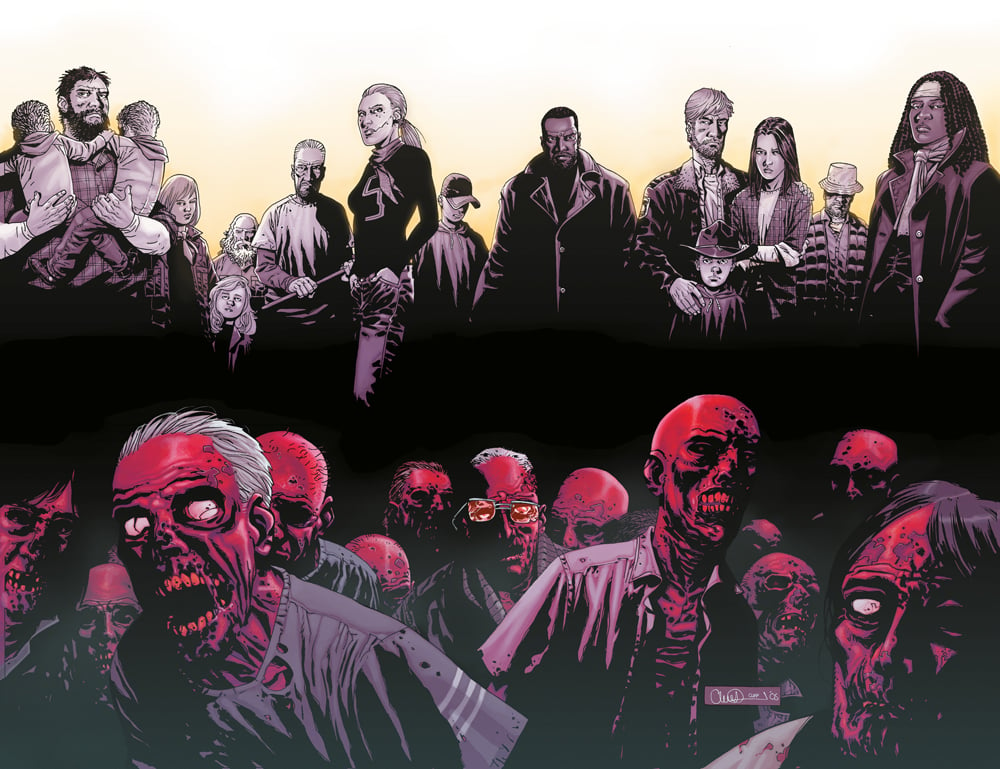
The Walking Dead: All Out War is all about survival, but with the state of the world post-apocalypse, survival isn’t all that easy. We have striven to create a game where the tension is always rising, forcing the players to be smart, creative, or just reckless in order to stay alive. It’s kill or be killed. We also wanted to include some typical war-gaming elements to properly engage those who want more than a board game experience.
So, how do you win a game of All Out War? The All Out War expansions will have a series of narrative scenarios allowing you to play out the events that unfolded in the comics – Rick and Glenn’s journey into Atlanta to find guns, the opening of Hershel’s barn, all the way through to the Governor’s assault on the prison. You can play these with the characters from the story or alternatively swap them out for characters of your choice – what if Michonne turned up early, or Shane survived to join the war against Woodbury?
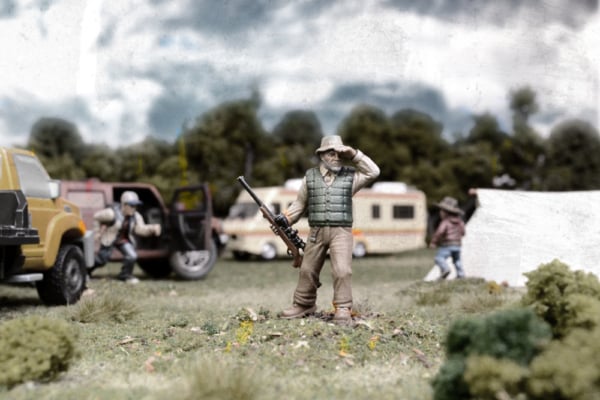
Outside of the narrative, the standard scenario for the game represents a supply run made by members of your group, with the objective being to collect supplies from locations around the board – stashes of food, clothing, ammunition, fuel, medicine, and so on. However, you won’t be the only one searching – there will be a rival group trying to get there first. The winner is the player who collects the most supplies, but to do that you will need to navigate the ever-present threat of the Walkers and outwit your opponent.
The standard game also presents the opportunity to build up your group in your own way, with a wide selection of characters and equipment suited to different playstyles. The characters and equipment are all presented on cards containing a points value and all of their rules, allowing for simple group-building and making it easy to expand the range in the future.
As time goes on, more clearly defined “factions” will enter the game, but even now, the limits on constructing your group are fairly minimal – new people aren’t always friendly at first, and do tend to switch allegiance from time to time! You don’t have to stick strictly to the alliances seen in the story – there are many points at which the tide could have turned and friend fights friend to survive!
[caption id="attachment_15218" align="aligncenter" width="600"]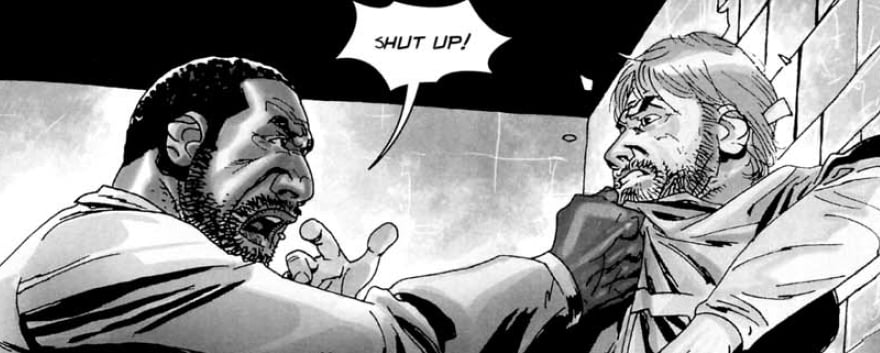 Tyreese fights Rick in the prison[/caption]
Tyreese fights Rick in the prison[/caption]
Groups are built around a Leader. This can be any character, but some have special abilities that apply when they are in charge, and can affect the playstyle of your group. A group built around Rick will be more tactical and cautious, whereas a group built around Shane may be more aggressive. Playing the two groups against each other will make for an interesting game. Lots of characters in the game are “neutral” (Derek, Liam, Patrick and Sandra for example) and can be used in any group, so it’s easy to come up with different group combinations, each with their own advantages and disadvantages.
Now you know how to put a group together, let’s look at the main challenge you will face in the game – Threat. Threat is a measure of how tense the atmosphere is – how scared your characters are, how pressured they feel, and how riled up the Walkers have become. The game includes a Threat Tracker, which is placed beside the board and moved up and down depending on the events in the game – gunshots, surprise Walker attacks, getting into melee, and so on.
Every character has a Nerve level, representing their ability to remain calm under such pressure. Once the Threat reaches their Nerve, they may Panic, with results such as screaming in fear, running away, hiding, or even going berserk! If that wasn’t enough, the higher the threat, the more the Walkers will take notice of the Survivors and attack in large numbers. Threat also serves as the game’s time limit – once it hits maximum it’s game over. A clever player may try to push it up to end the game while they’re ahead, while their opponent tries to reduce it to regain the advantage. Managing the Threat is a hugely important part of the game.
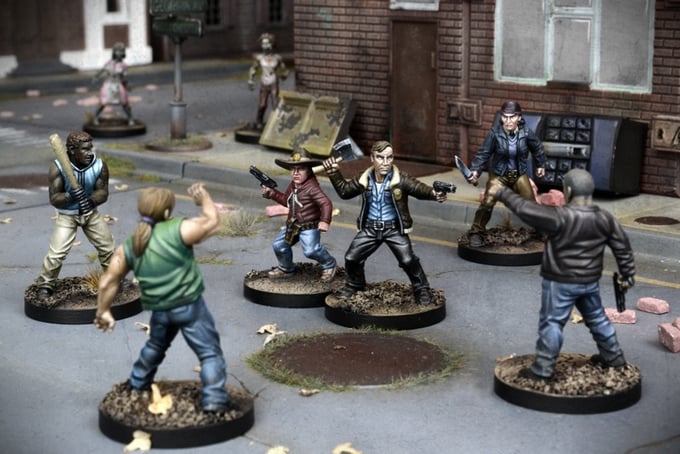
As Mantic fans will appreciate, the core mechanics behind the game have been kept as simple as possible, reducing the learning curve while allowing players to spend their time devising cunning tactics rather than looking up rules.
The game uses alternate activation, with Survivors taking turns making various actions. Each can make two different choices, with options such as moving, shooting, searching, hiding and making noise to draw a Walker close. Melee is not an action in its own right, and is instead completed all at once later in the turn, once all the Walkers have joined in!
Shooting and Melee are carried out using simple opposed rolls like DreadBall or Deadzone – the difference in successes equals the damage dealt. These rolls are made with dice designed especially for the game, with varying numbers of successes on the faces and different colours for attacks of different strengths. These custom dice allow for more subtle combinations without complicating the rules or introducing extreme rolls. In addition to a number of successes, some of the faces also have a headshot symbol – vital if you don’t want the Walkers to get back up again…
The colours are used for the stats in the game – Rick’s Survivor card shows a white dice symbol for melee, whereas a Walker has a red dice symbol – these show which dice to roll for an attack. Equipment cards can add extra dice to a Survivor’s rolls as well.
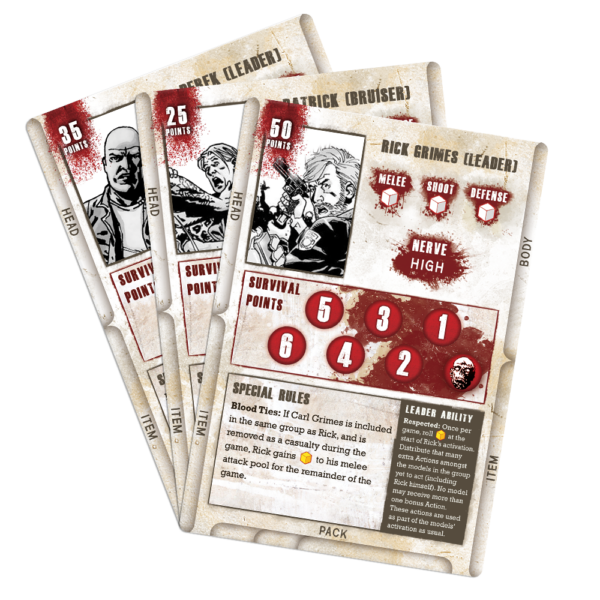
So that’s how Survivors work, but what about Walkers? All Out War uses a unique AI system to move the Walkers, so you don’t need a player to control them. This system moves them in three different ways:
NOISE and MAYHEM. Just as you will have seen from the story, your life can depend on staying quiet and still, and the game is no different. Certain actions in the game can’t be done quietly, and taking them will draw Walkers close. For example, Sneaking (4" move) is silent, but Running (8" move) causes NOISE, meaning that once the action is complete the nearest Walker within 8"will move directly towards the Survivor. Firing a gun on the other hand is much louder, and causes MAYHEM. This works in the same way, but all Walkers within 8" will move towards the survivor.
MAYHEM also increases the Threat level by one, so it’s a dangerous thing to do! Survivors can also choose to make
NOISE to direct the Walkers where they want them, and there are other things that cause MAYHEM such as car alarms.
The Kill Zone. After all Survivors have taken their actions, the Kill Zone template (5" diameter) is placed over each Walker on the board. If there is a survivor within range, the Walker will move into melee with it immediately. It’s wise to give Walkers a wide berth.
The Event Cards. These are drawn every turn after checking the Kill Zones. Each will have a list of effects that must be carried out immediately. Usually these will involve moving Walkers or bringing new Walkers onto the board in different ways, but there are some special events – things like car alarms and thunderstorms. In most cases the players take it in turns to move the Walkers in a direction of their choice, but some cards will specify a direction. The effects of the cards vary depending on the Threat Level – at Low Threat a card may move only a few Walkers, but at High Threat every Walker on the board could move. Players need to bear this in mind when positioning their Survivors – it can be hard to judge where nearby Walkers will end up, especially as the cards often increase the Threat Level themselves.
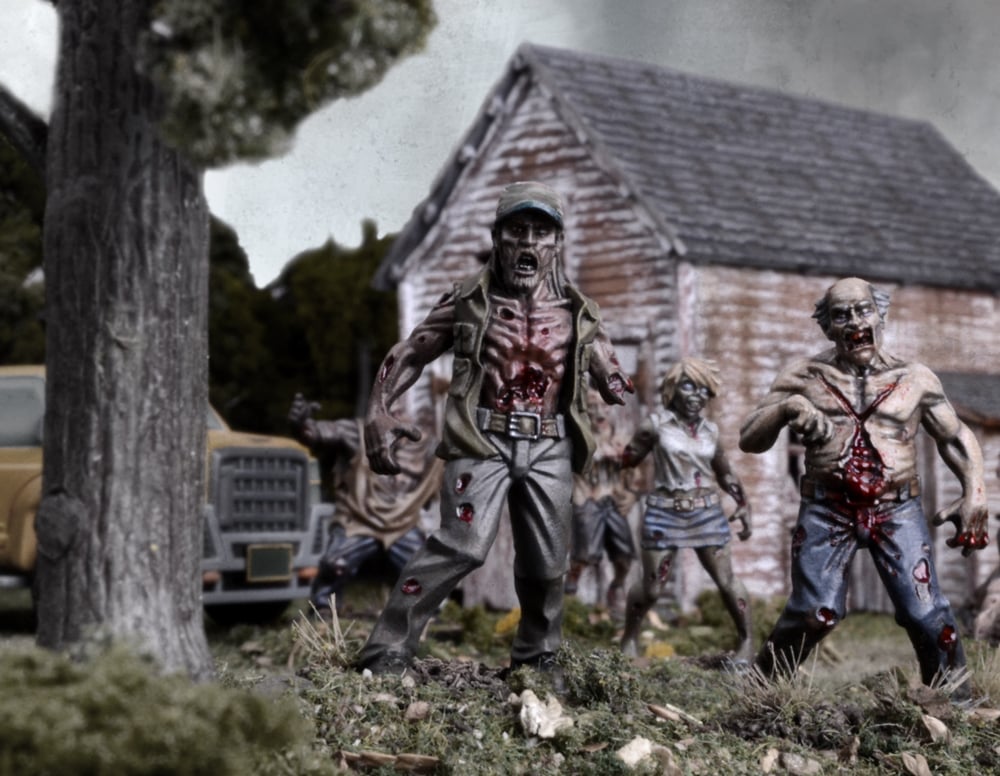
One advantage that the Survivors have is that Walker movement is predictable. They always move in straight lines, and they always move at a Shamble (6"). They must stop when they reach a piece of scenery and cannot walk around it until the next time they move. Players can use this knowledge to their advantage – using barricades to keep Walkers at bay while they shoot their guns, or even getting behind the opponent’s models and drawing the Walkers directly into them. Many a playtest game has been won not by attacking the opposing group, but by letting the Walkers do the job for you! Walkers are particularly dangerous when in numbers as they get extra dice for outnumbering, so drawing a group of them onto an opponent spells certain doom.
That’s pretty much it for the core mechanics. We’ll be getting the playtest rules up shortly so you can look at everything in more detail. Everything you need to play will be included, but there is more to come before the game goes to print. We will still be adding sections on basic terrain types (elevated positions, buildings, etc) and some rules for simple character generation and campaign games to keep you playing long into the future!
The Walking Dead: All Out War miniature skirmish game is now on Kickstarter. It closes midnight (GMT) 29th February.

 GBP
GBP  EUR
EUR  USD
USD